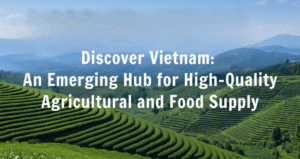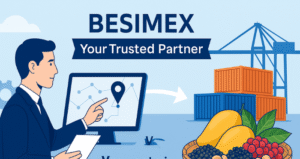Vietnam has rapidly emerged as a powerhouse in global agriculture, consistently ranking among the world’s leading exporters of rice, coffee, seafood, and various fruits and vegetables. For international businesses looking for high-quality, diverse, and competitively priced agricultural goods, sourcing agricultural products Vietnam is an increasingly attractive option. This guide provides insights into why Vietnam is a promising source and offers tips for buying from Vietnam effectively.
Why Source from Vietnam?
Vietnam boasts a favorable tropical climate, fertile land, and a long coastline, creating ideal conditions for cultivating a wide array of agricultural and aquatic products. Beyond these natural advantages, several factors make Vietnam a strategic sourcing location:
- Diverse Product Range: From staple crops like rice and coffee to tropical fruits (dragon fruit, mango, durian), vegetables, nuts (cashew), spices (pepper), and a vast variety of seafood (pangasius, shrimp), Vietnam offers remarkable product diversity.
- Increasing Focus on Quality & Standards: Recognizing the demands of international markets, Vietnamese producers and the government are placing greater emphasis on improving quality, food safety, and sustainability standards. Adherence to international certifications like GlobalG.A.P., Organic, HACCP, BRC, and VietGAP (Vietnam’s domestic standard, often a stepping stone to international ones) is becoming more common.
- Competitive Pricing: While quality is rising, Vietnam generally maintains competitive pricing compared to many other sourcing regions.
- Trade Agreement Advantages: Vietnam is a signatory to numerous Free Trade Agreements (FTAs), including the EVFTA (with the EU), UKVFTA (with the UK), CPTPP, and RCEP. These agreements often mean reduced or eliminated tariffs for agricultural products imported from Vietnam, offering significant cost advantages to buyers in member countries.
- Improving Infrastructure & Logistics: Vietnam’s infrastructure, particularly ports and logistics services connecting key production areas to export hubs, is continuously improving, facilitating smoother trade flows.
Key Agricultural Products to Consider Importing from Vietnam
When you import food from Vietnam, you have a wide selection. Some of the most prominent product categories include:
- Rice: Vietnam is a top rice exporter, known for various types including fragrant rice (ST25 being a prime example), japonica, and glutinous rice.
- Coffee: A leading robusta producer, Vietnam is also growing its output of higher-quality arabica and specialty coffees.
- Cashew Nuts: Vietnam is the world’s largest processor and exporter of cashew nuts.
- Seafood: Pangasius ( basa fish) and shrimp are major export powerhouses, alongside other aquaculture and wild-caught varieties.
- Fruits & Vegetables: A rapidly growing sector with strong demand for tropical fruits like dragon fruit, mango, durian, longan, lychee, and processed vegetables.
- Pepper: Vietnam is a major global supplier of black pepper.
- Other Products: Tea, rubber, spices, and various processed agricultural goods are also significant exports.
Tips for Buying from Vietnam
Successfully sourcing agricultural products Vietnam requires careful planning and execution. Here are some essential tips for buying from Vietnam:
- Define Your Quality Requirements Clearly: Be specific about the standards, certifications, and quality specifications your market demands. Request relevant certificates (GlobalG.A.P., Organic, HACCP, etc.) upfront.
- Conduct Thorough Due Diligence: Don’t rely solely on online listings. Whenever possible, visit farms or processing facilities, request samples, and verify business registrations and export licenses.
- Consider Working with Reputable Partners:
- Trading Companies/Exporters: Many experienced Vietnamese trading companies specialize in specific products or markets. They can help navigate logistics, quality control, and export procedures.
- Industry Associations: Contacting relevant Vietnamese industry associations (e.g., Vietnam Food Association, Vietnam Coffee & Cocoa Association, VASEP for seafood) can provide access to lists of reputable members.
- Trade Promotion Agencies: Organizations like Vietrade (Vietnam Trade Promotion Agency) and the Trade Offices of Vietnam in your country can offer valuable information and connect you with potential suppliers.
- Attend Trade Fairs: Participating in major agricultural and food trade shows in Vietnam (like Vietfood & Beverage, AgroViet) allows you to meet multiple suppliers face-to-face and inspect products directly.
- Understand Logistics and Payment Terms: Discuss logistics options (FOB, CIF, etc.) and payment terms (Letters of Credit are common for new relationships, Telegraphic Transfers might be used for established partners) clearly.
- Be Mindful of Language and Cultural Differences: While many exporters have English-speaking staff, clear communication is key. Consider using translation services if needed and be patient with potential cultural nuances.
- Stay Updated on Regulations: Import regulations, phytosanitary requirements, and labeling laws vary by destination country. Ensure your Vietnamese supplier understands and can comply with the specific requirements of your market.
Vietnam Export Trends 2025
Looking ahead to export trends Vietnam 2025, several key directions are evident:
- Shift to Value-Added Products: There’s a strong push towards exporting more processed and value-added goods (e.g., roasted coffee, dried fruits, ready-to-eat seafood) rather than just raw commodities, capturing more value in the supply chain.
- Sustainable and Organic Focus: Demand for sustainably produced and organic agricultural products is rising globally, and Vietnamese exporters are increasingly investing in meeting these standards.
- Digital Transformation: E-commerce platforms and digital technologies are playing a larger role in connecting Vietnamese suppliers with international buyers, streamlining communication and transactions.
- Leveraging FTA Benefits: Vietnamese exporters will continue to strategically utilize the tariff advantages offered by FTAs to increase market share in key regions like the EU, UK, and CPTPP member countries.
- Improved Traceability: Government initiatives and market demands are driving better traceability systems, allowing buyers to track the origin and journey of products.
Conclusion
Vietnam offers a compelling proposition for international buyers seeking to source agricultural products Vietnam. With a diverse product portfolio, growing emphasis on quality and international standards, competitive pricing, and the advantages conferred by numerous trade agreements, the opportunities are significant, particularly highlighted by the export trends Vietnam 2025.
While navigating the sourcing process requires due diligence and clear communication, following these tips for buying from Vietnam and building strong relationships with reliable suppliers can unlock access to a wealth of high-quality agricultural goods to import food from Vietnam successfully.


